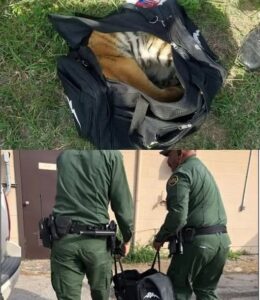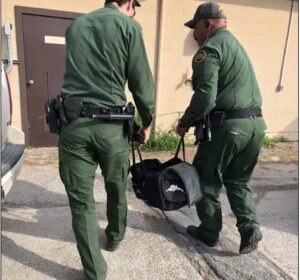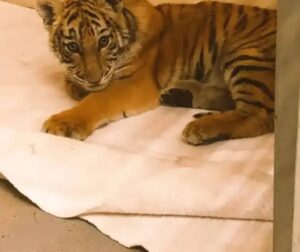Tiger Cub Found in Duffel Bag at Border Becomes a Global Symbol of Hope

The sun was setting over Brownsville, Texas, painting the Rio Grande in deep gold as Border Patrol agents began their evening rounds. Dusk is never a quiet time along the border — it’s when movement stirs in the shadows. Migrants searching for refuge, smugglers moving contraband, and traffickers carrying lives — both human and animal — often emerge under the fading light.
That night, agents spotted three men walking cautiously along the riverbank. One of them struggled under the weight of a large, oddly shaped black duffel bag. When the agents drew near, the men suddenly dropped the bag and bolted into the brush, vanishing into the darkness.
Approaching carefully, the agents unzipped the bag — and froze. Inside lay a tiny tiger cub, barely three or four months old, shivering and gasping for air. Its striped fur was damp and dirty, its small chest rising unevenly. The agents quickly realized they weren’t dealing with drugs or weapons, but something just as illegal — and far more innocent.
A Life Saved on the Border
The agents acted fast. They radioed for help, and the cub was rushed to the Gladys Porter Zoo, where veterinarians and animal care specialists began an urgent rescue effort. The frail cub was dehydrated, weak, and dangerously cold. The team provided fluids, warmth, and round-the-clock care.
They named him Zuko — a fitting name for a survivor born from fire and danger.
At first, no one knew if he would live through the night. But slowly, Zuko began to stir, open his eyes, and respond to the gentle hands caring for him. Each small sign of strength felt miraculous.

A Rare Rescue and a Stark Reality
Zuko’s survival became more than a heartwarming story — it exposed the ugly reality of illegal wildlife trafficking. While this cub found safety, thousands of animals like him aren’t as fortunate. Experts estimate fewer than 3,200 tigers remain in the wild, while shockingly, around 5,000 live in captivity in the United States — many in unregulated private facilities.
These animals are often bred, traded, and transported in horrific conditions. Smugglers hide them in duffel bags, boxes, or crates, treating endangered creatures like contraband. The same routes used for drugs or human trafficking often double as corridors for exotic animal smuggling — a global criminal network worth billions.
From the Brink to a Second Chance
Zuko’s rescue was a rare victory. For the agents who found him and the zoo team who saved him, it became a symbol of compassion amid cruelty. His recovery highlighted the importance of stronger border enforcement, better international cooperation, and increased public awareness about wildlife exploitation.
Every rescued animal represents a life reclaimed — and a step toward dismantling a brutal industry that profits from suffering.

The Broader Battle Against Trafficking
Organizations like the Gladys Porter Zoo and conservation groups across the U.S. continue to push for tighter laws on exotic animal ownership and tougher penalties for traffickers. They also urge the public to reject the fascination with owning wild animals — a demand that fuels the cycle of abuse.
Border Patrol agents are now being trained to identify and respond to wildlife crimes, as these operations increasingly overlap with human and drug smuggling networks. Zuko’s story has inspired discussions about giving law enforcement the tools they need to combat these hidden forms of trafficking.
More Than a Rescue — A Reminder
For those who witnessed it, Zuko’s rescue became a deeply emotional moment. The small tiger’s survival wasn’t just about saving one life — it was about confronting the reality that wildlife trafficking happens right here, not just overseas.
His story calls on all of us to stay vigilant, to report illegal animal trade, and to support conservation efforts that protect species on the brink of extinction.
As Zuko grows stronger under expert care, his journey continues to touch hearts around the world. He stands as a reminder that even in a world filled with cruelty, human compassion still has the power to change destinies.
This wasn’t just the story of a tiger in a bag.
It was the story of humanity — at its most watchful, most courageous, and most kind.